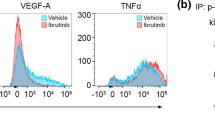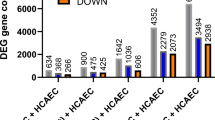Abstract
As an Old World nonhuman primate, baboons have been extensively used for research on dyslipidemia and atherogenesis. With increasing knowledge about the endothelium's role in the initiation and progression of atherosclerosis, the value of the baboon model can be increased by developing it for research on the role of dysfunctional endothelium in atherogenesis. Toward that goal, we have established and validated methods of isolating and culturing baboon femoral artery endothelial cells (BFAECs) and compared baboon endothelial cellular characteristics with those of humans. Our results indicated that baboon and human endothelial cells share similar growth and culture behaviors. As was the case for human endothelial cells, BFAECs responded to tumor necrosis factor (TNF)-α stimulation with increased expression of adhesion molecules (maximum increase for intracellular adhesion molecule (ICAM): 1.76±0.26-fold; vascular cell adhesion molecule (VCAM): 1.65±0.25-fold; E-selectin: 2.86±0.57-fold). However, BFAECs were hyporesponsive to lipopolysaccharide (LPS) (range, 0.25–20 μg/mL) in adhesion molecule expression, whereas 1 μg/mL LPS induced 2.14- to 3.71-fold increases in human endothelial cells. The differential responses to LPS were not related to TLR-2 and toll-like receptor (TLR)-4 expression on the cell surface. And baboon microvascular endothelial cells had similar features as BFAECs. We observed constitutive expression of interleukin (IL)-6, IL-8, granulocyte macrophage colony-stimulating factor (GM-CSF), and monocyte chemoattractant protein (MCP)-1 in both human and baboon endothelial cells, and these cytokines were further induced by TNF-α and LPS. We also demonstrated that the responses to TNF-α or LPS varied among baboons maintained under the same dietary and environmental conditions, suggesting that response may be controlled by genetic factors.
Similar content being viewed by others
References
Lusis, A. L. (2000) Atherosclerosis. Nature 407, 233–241.
Ross, R. (1993) The pathogenesis of atherosclerosis: a perspective for the 1990s. Nature, 362, 801–809.
Haskard, D. O. and Landis, R. C. (2002) Interactions between leukocytes and endothelial cells in gout: lessons from a self-limiting inflammatory response. Arthritis Res. 4 Suppl 3, S91-S97.
Hennig, B., Toborek, M., and McClain C. J. (2001) High-energy diets, fatty acids and endothelial cell function: implications for atherosclerosis. J. Am. Coll. Nutr. 2001; 20(2 Suppl), 97–105.
Libby, P. (2002) Inflammation in atherosclerosis. Nature 420, 868–874.
Krieglstein, C. F. and Granger, D. N. (2001) Adhesion molecules and their role in vascular disease. Am. J. Hypertens. 14, 44S-54S.
Tailor, A. and Granger, D. N. (2000) Role of adhesion molecules in vascular regulation and damage. Curr. Hypertens. Rep. 2, 78–83.
Ikeda, U., Matsui, K., Murakami, Y., and Shimada, K. (2002) Monocyte chemoattractant protein-1 and coronary artery disease. Clin. Cardiol. 25, 143–147.
Gerszten, R. E., Garcia-Zepeda, E. A., Lim, Y. C., Yoshida, M., Ding, H. A., Andrew, G., et al. (1999) MCP-1 and IL-8 trigger firm adhesion of monocytes to vascular endothelium under flow conditions. Nature 398, 718–723.
Kushwaha, R. S. and McGill, H. C., Jr. (1998) Diet, plasma lipoproteins and experimental atherosclerosis in baboons (Papio sp.). Hum Reprod Update 4, 420–429.
Kammerer, C. M., Cox, L. A., Mahaney, M. C., Rogers, J., and Shade, R. E. (2001) Sodium-lithium countertransport activity is linked to chromosome 5 in baboons. Hypertension 37, 398–402.
Rainwater, D. L., Kammerer, C. M., Cox, L. A., Rogers, J., Carey, K. D., Dyke, B., et al. (2002) A major gene influences variation in large HDL particles and their response to diet in baboons. Atherosclerosis 163, 241–248.
Cox, L. A., Birnbaum, S., and VandeBerg, J. L. (2002) Identification of candidate genes regulating HDL cholesterol using a chromosomal region expression array. Genome Res. 12, 1693–1702.
Amberger, A., Maczek, C., Jurgens G., Michaelis, D., Schett, G., Trieb, K., et al. (1997) Co-expression of ICAM-1, VCAM-1, ELAM-1 and Hsp60 in human arterial and venous endothelial cells in response to cytokines and oxidized low-density lipoproteins. Cell Stress Chaperones 2, 94–103.
Hewett, P. W. and Murray, J. C.. Isolation, culture and properties of microvessel endothelium from human breast adipose tissue. In: Endothelial cell culture. (Bicknell, R., ed.) Cambridge Press, New York, 1996, pp. 55–76.
Klein, C. L. (1994) Comparative studies on vascular endothelium in vitro. Pathobiology 62, 199–208.
Shen, J., Ham, R. G., and Karmiol, S. (1995) Expression of adhesion molecules in cultured human pulmonary microvascular endothelial cells. Microvasc. Res. 50, 360–372.
Zhang, F., Yu, W., Hargrove, J. L., Greenspan, P., Dean, R. G., Taylor, E. W., et al. (2002) Inhibition of TNF-alpha induced ICAM-1, VCAM-1 and E-selectin expression by selenium. Atherosclerosis 161, 381–386.
Schmidt, A., Goepfert, C., Feitsma, K., and Buddecke, E. (2002) Lovastatin-stimulated superinduction of E-selectin, ICAM-1 and VCAM-1 in TNF-alpha activated human vascular endothelial cells. Atherosclerosis 164, 57–64.
Protocols of harvesting endothelial cells. (2003) http://vrd.bwh.harvard.edu/core_facilities/ cell_bio_protocols.html.
Briscoe, D. M., Cotran, R. S., and Pober, J. S. (1992) Effects of tumor necrosis factor, lipopolysaccharide, and IL-4 on the expression of vascular cell adhesion molecule-1 in vivo. Correlation with CD3+ T cell infiltration. J. Immunol. 149, 2954–2960.
Zurovsky, Y., Laburn, H., Mitchell, D., and MacPhail, A. P. (1987) Responses of baboons to traditionally pyrogenic agents. Can. J. Physiol. Pharmacol. 65, 1402–1407.
Redl, H., Bahrami, S., Schlag, G., and Traber, D. L. (1993) Clinical detection of LPS and animal models of endotoxemia. Immunology 187, 330–345.
Rogers, J., Mahaney, M. C., Witte, S. M., et al. (2002) A genetic linkage map of the baboon (Papio hamadryas) genome based on human microsatellite polymorphisms. Genomics 67, 237–247.
Author information
Authors and Affiliations
Corresponding author
Rights and permissions
About this article
Cite this article
Shi, Q., Wang, J., Wang, X.L. et al. Comparative analysis of vascular endothelial cell activation by TNF-α and LPS in humans and baboons. Cell Biochem Biophys 40, 289–303 (2004). https://doi.org/10.1385/CBB:40:3:289
Issue Date:
DOI: https://doi.org/10.1385/CBB:40:3:289




